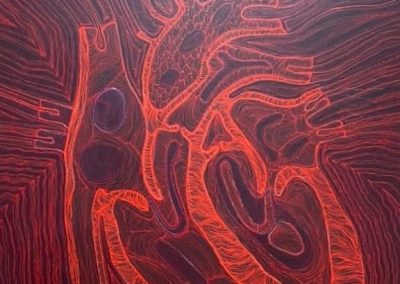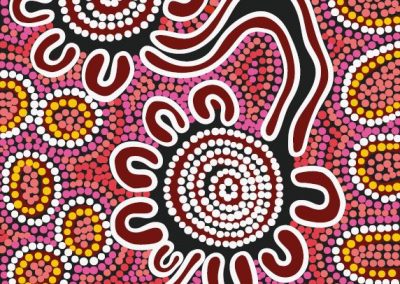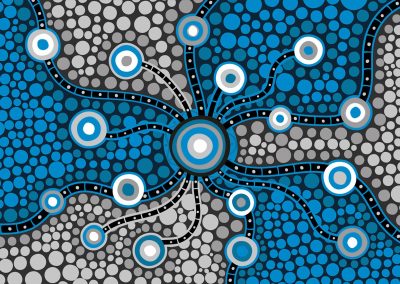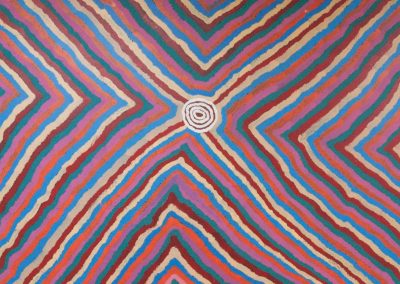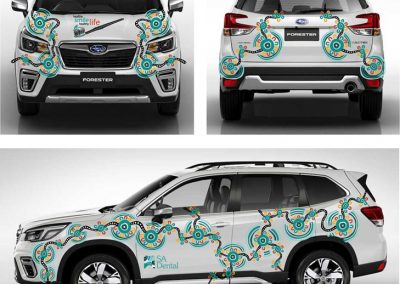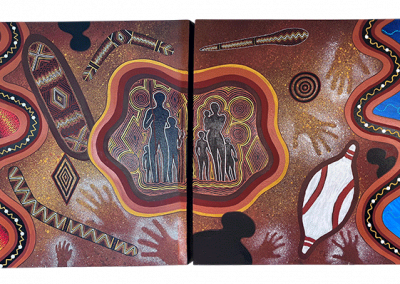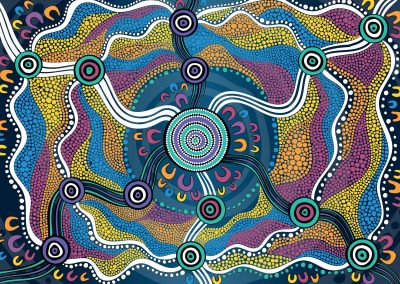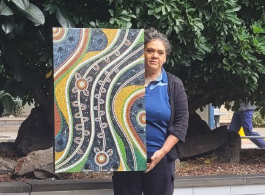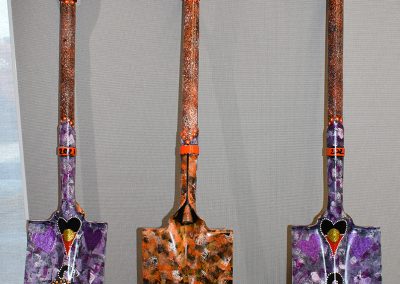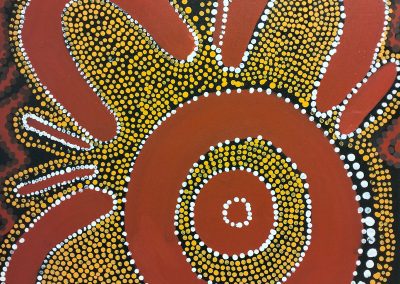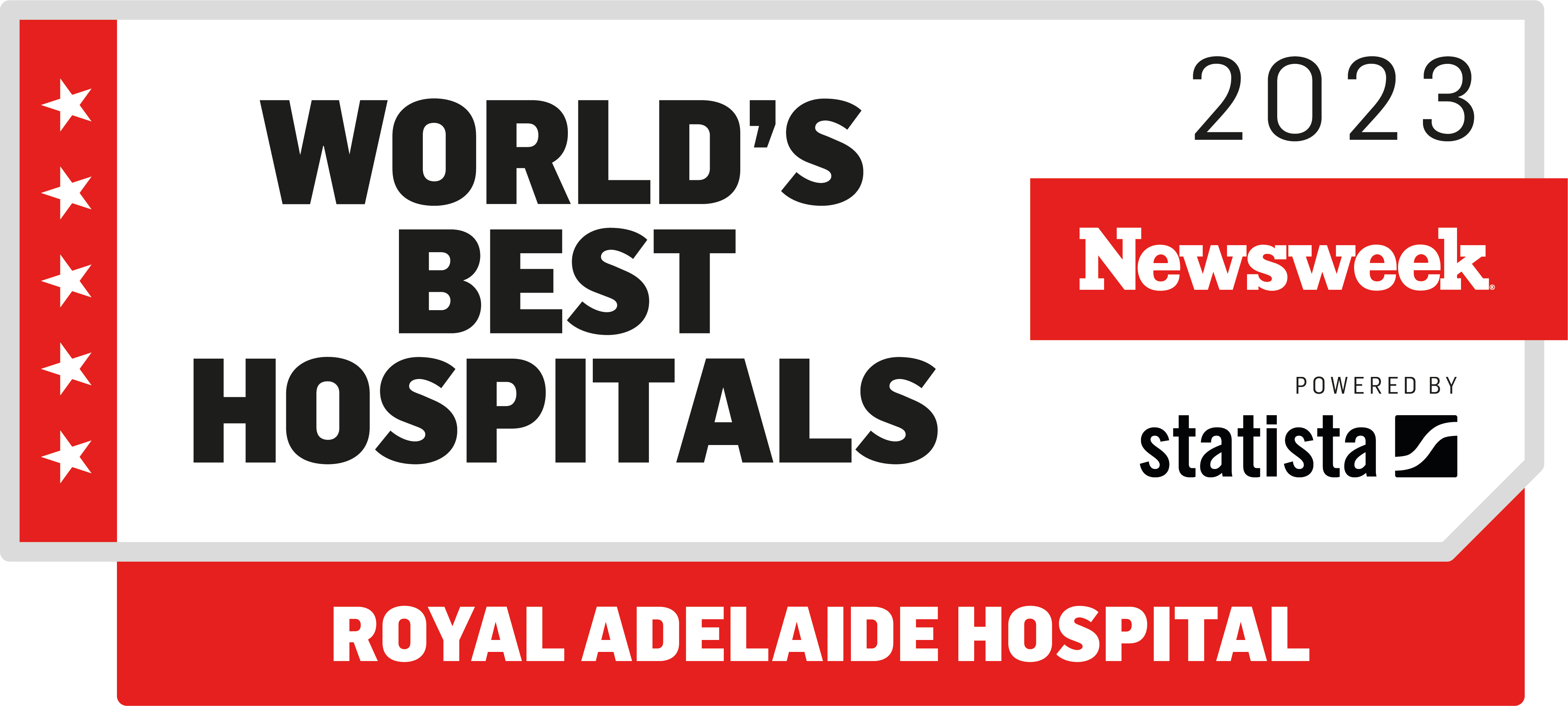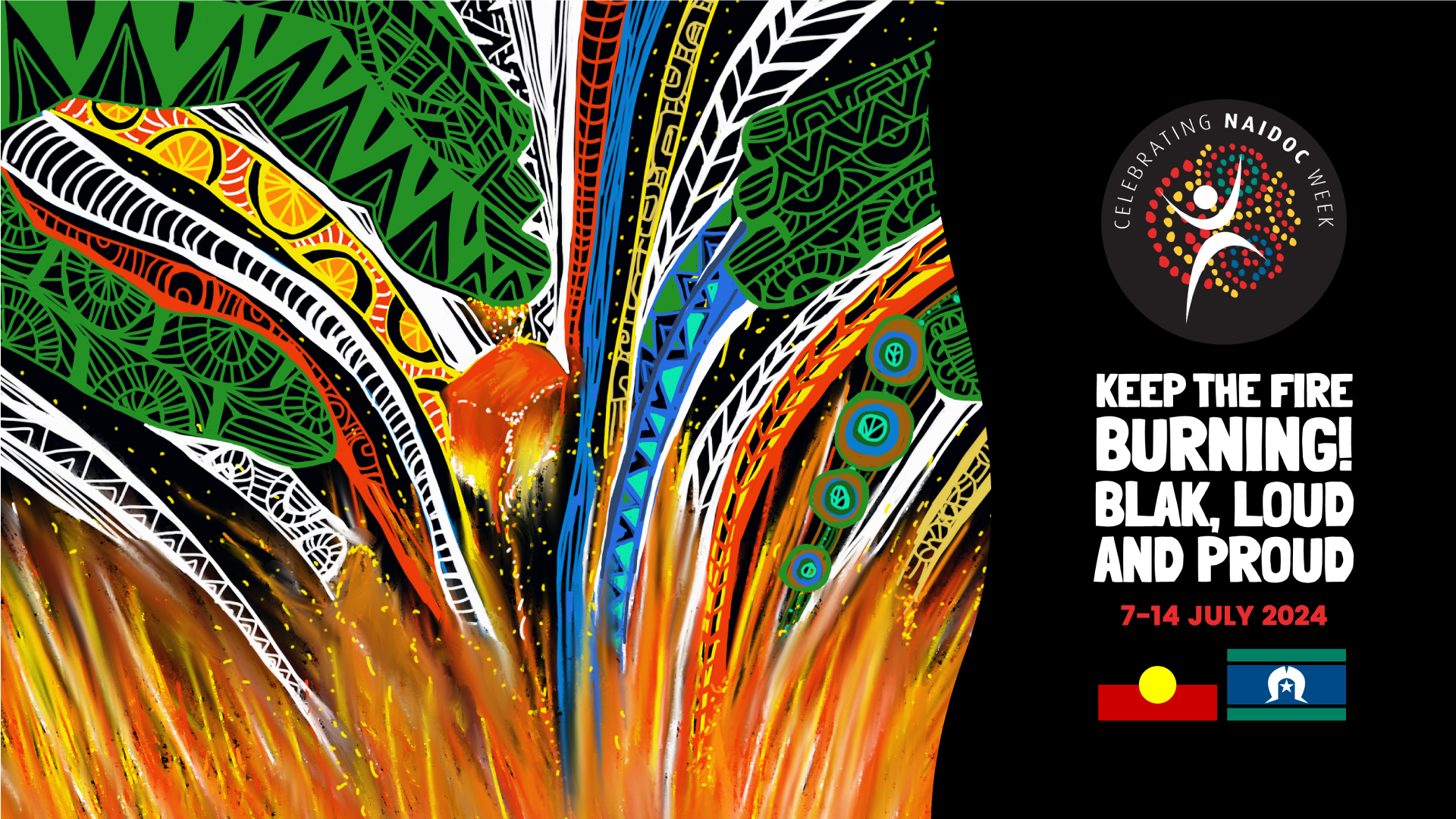
NAIDOC gallery 2024
CALHN is proud to display a number of artworks created by members of the Aboriginal and Torres Strait Islander community at sites across our network.
These artworks all tell a story, and contribute to our sites being culturally safe for Aboriginal staff, consumers and their families.
Read about the inspiration behind the art, the artists and click on the images to see the full gallery.
Kututu (heart) artwork by Robert Fielding
Proudly on display in the Coronary Care Unit at The Queen Elizabeth Hospital, this painting is by artist Robert Fielding, who is himself a cardiac patient that the Cardiology team look after when visiting the APY lands. Fielding says of the painting: “The organ in this painting, kututu, is hidden inside our body. It is with us every day, through feelings of love and hate, success and disappointment. It keeps us going in its constant rhythm, like our song and dance. It is very important that we as Anangu are aware of the sudden illnesses that affect our people, that can stop our heartbeat in a moment. This painting shows the heart as part of our song lines, as part of our country, our culture.” Robert lives in Mimili Community, home to 300 Pitjantjatjara and Yankunytjatjara people who have been living in the area for millennia in harmony with nature and acting as custodians of the land and the Tjukurpa (creation stories).”
Story of breast screening artwork by Audrey Brumby
This artwork was commissioned by BreastScreen SA in 2017 to tell the story of breast cancer screening by First Nations Peoples living in South Australia. It is used as the foundation of the program’s Indigenous branding, and is often commented on for its beautiful colours and striking nature. Artist Audrey Brumby, an Aboriginal woman from Ernabella in far north SA, uses several techniques and motifs within the artwork that are part of her traditional culture, including the traditional dot painting depicting her dreamtime. This piece tells the story of breast cancer screening. The larger circle of U shapes represents women coming together for screening. There is a line showing one woman moving to a smaller circle of women at the top of the image, representing someone being recalled for Assessment – a small subset of our clients. There is a second line showing a woman returning to screening following her Assessment appointment. This demonstrates that being recalled to Assessment is usually not the end of a woman’s screening journey – she may return for screening if she is cleared at Assessment, or she may return to screening post treatment if all is well.
SA Pharmacy artwork by Jordan Lovegrove
This artwork by Ngarrindjeri artist Jordan Lovegrove, depicts SA Pharmacy’s relationship with South Australian hospitals, the many out of hospital services they provide and commitment to Closing the Gap. SA Pharmacy is represented by the large central meeting place and the South Australian metropolitan and rural public hospitals by the smaller meeting places. SAP provide clinically led, cost efficient, professional pharmacy services to the hospitals, shown by the pathways leading between them. The pathways going beyond the hospitals represent the range of out of hospital services through Drug and Alcohol Services SA, SA Ambulance Services and SA Prison Health Service. SAP’s Commitment to Closing the Gap, including improving access to medicines for Aboriginal people, is shown by the dotted patterns throughout the artwork.
Wanampi Dreaming – the Rainbow Serpent – artwork by Rama Kaltu-Kaltu Sampson
Rama Kaltu-Kaltu Sampson was born in Mt. Davis, Pipalyatjara, in the Anangu Pitjantjatjara Yankunytjatjara (APY) Lands, before his family came into contact with Europeans in Australia. Rama was an accomplished painter and a highly regarded traditional Ngangkari – doctor and spiritual healer- in his liftime. As an Anangu elder, Rama possessed a great wealth of traditional knowledge and skills. Rama’s country was Kuntjanu, and was the custodian of the Wanampi Tjukurpa – Rainbow Serpent Dreaming. This artwork was kindly donated to the Coronary Care Unit of The Queen Elizabeth Hospital in 2009.
SA Dental car wrapped in artwork by Allan Sumner
The SA Dental Aboriginal Oral Health Program staff all work at grass roots with community people, providing dental information, programs, and services. In 2021, Ngarrindjeri, Kaurna and Yankunytjatjara artist Allan Sumner designed artwork to apply to one of SA Dental Government cars. The narrative speaks about education and going to different communities and events to promote dental hygiene.
Mother Earth-Father Sky by David Thorpe and Jacinta Dixon
Mother Earth-Father Sky by David Thorpe and Jacinta Dixon can be found at the Queen Elizabeth Hospital, originally displayed as part of National Reconciliation Week 2019. Thorpe and Dixon are two South Australian artists who have been practicing their individual art forms for many years. Their work has been exhibited in and around Adelaide including Tandanya National Cultural Institute, Marion Culture Centre and Greenhill Gallery. Their work identified the key elements of what keeps individuals, families and communities together. All these elements are seen as essential for survival and to stay healthy and strong. The artwork has broad South Australian Aboriginal cultural references and also reflects animals and totems important to Aboriginal people from the Adelaide region.
CALHN Reconciliation Action Plan artwork
Designed by accomplished Aboriginal South Australian artist Allan Sumner, a descendant of the Ngarrindjeri, Kaurna and Yankunytjatjara people, the RAP artwork was created to demonstrate and represent Central Adelaide LHN’s important role in improving the health and wellbeing of South Australians, by delivering world-class integrated healthcare and hospital services. The circle in the middle of the artwork represents the ‘Wardli Purrutinthi’ – place to live or to be alive – and represents Central Adelaide LHN being central to connecting the hospitals, community health services and clinical services together.
SA Dental’s Aboriginal Oral Health Plan (AHOP) artwork by Allan Sumner
This artwork, by artist Allan Sumner, is a reflection of SA Dental’s Aboriginal Oral Health Program (AOHP). The AOHP works within the community, enabling South Australian’s to achieve better oral health and wellbeing through: health promotion, timely dental treatment with a focus on prevention, early intervention and support for education and research. The artwork has three main themes which include elements that reflect oral health, water and land. The artwork is also a reflection of AOHP journey. Working at grass roots withcommunity people, providing dental information, programs and services.
Healers Hands by Delwyn Mannix
Artist Delwyn Mannix, pictured, is the artist of Healers Hands, which is displayed at the ISS Unit at the Queen Elizabeth Hospital. She says of her painting: “My Ancestors are the Wangkangurra Yarlugandi people of the Simpson Desert, and I have been painting for almost 25 years. In 2008 I was involved in an exhibition called “Saltbush, children’s cheering carpet”. Healers Hands represents the doctors healing people. It isn’t just my story, but the story of all who come to be healed here at the The Queen Elizabeth Hospital. I find this title appropriate, as my people also have healers in the desert country. The hands represent doctors and nurses, (healers), and the larger circles represent meeting places where patients receive their treatment. The horseshoe shapes depict the patients waiting in line to be seen by the healers, and the waves represent the sand dunes from the country of my ancestors, the Simpson Desert. The starry night shows that healing doesn’t just occur in the daylight hours.”
Artwork painted on shovels by Amanda Jackson-Brown
Celsus commissioned artwork from Adnyamathanha and Ngarrindjeri Artist Amanda Jackson-Brown, to commemorate the planting of the Tuckeroo reconciliation tree at the Royal Adelaide Hospital. The artist painted the shovels that were used in the planting of the reconciliation tree, describing the different elements of the artwork and their meaning: “The Tree of Life signifies planting love together. The Ochre signifies Mother Earth and the land our Mother. The meeting place and campfire signifies people sitting together, learning and healing through past traumas. The artwork is for my Elders, past and present.”
Marra Dreaming Indigenous Artists artwork at BreastScreen SA
On display at BreastScreenSA, this artwork was developed by Marra Dreaming Indigenous Artists. It was one of ten pieces developed and painted as part of a community event to recognise Reconciliation Week in 2007.
SAMI Aboriginal artwork
SA Medical Imaging artwork by Jordan Lovegrove In September 2023, SA Medical Imaging (SAMI) partnered with local Ngarrindjeri artist Jordan Lovegrove to create the SAMI Aboriginal artwork. The artwork portrays the essential role of SAMI as the primary provider of public medical imaging services in South Australia. SAMI is represented as a central meeting place, surrounded by five people symbols, each representing SAMI’s core ICARE values: integrity, compassion, accountability, respect, and excellence. The pathway cutting through the centre of the artwork signifies patients’ healthcare journey. On either side of this path, footprints and symbols representing people illustrate SAMI’s support during this journey. Additional meeting places denote the network of hospitals and healthcare facilities offering public medical imaging services, while scattered dots represent the communities and families served by SAMI.
All artworks are displayed in their original form to uphold the artist’s intellectual property and narrative of the artwork.
Get further information regarding First Nations Cultural and Intellectual Property in the Arts from the Australia Council.
We acknowledge and pay respect to the First Nations Kaurna people upon whose ancestral land the Central Adelaide Local Health Network (CALHN) provides services.
We acknowledge the relationship and deep feelings of attachment between Aboriginal and Torres Strait Islander peoples and Country, and we acknowledge the traditional owners and custodians of the many lands from which our Aboriginal and Torres Strait Islander consumers travel to receive services.
The Central Adelaide Local Health Network website is licensed under a Creative Commons Attribution 3.0 Australia Licence. © Copyright 2025
